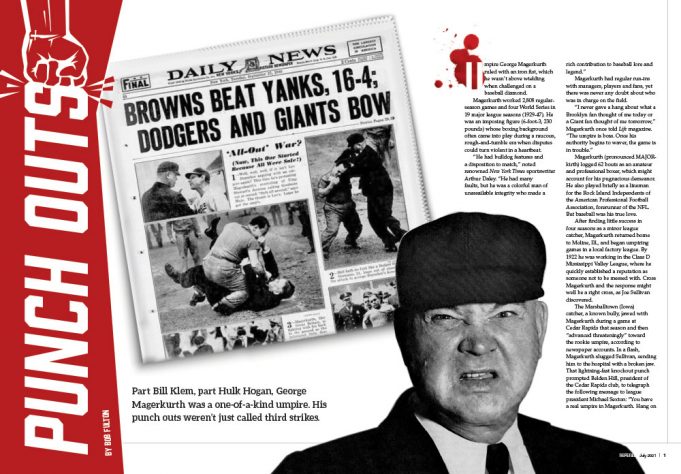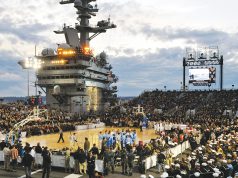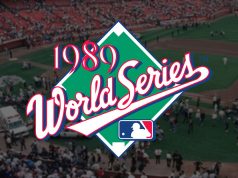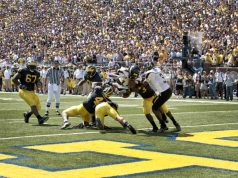S
Umpire George Magerkurth ruled with an iron fist, which he wasn’t above wielding when challenged on a baseball diamond.
Magerkurth worked 2,808 regular-season games and four World Series in 19 major league seasons (1929-47). He was an imposing figure (6-foot-3, 230 pounds) whose boxing background often came into play during a raucous, rough-and-tumble era when disputes could turn violent in a heartbeat.
“He had bulldog features and a disposition to match,” noted renowned New York Times sportswriter Arthur Daley. “He had many faults, but he was a colorful man of unassailable integrity who made a rich contribution to baseball lore and legend.”
Magerkurth had regular run-ins with managers, players and fans, yet there was never any doubt about who was in charge on the field.
“I never gave a hang about what a Brooklyn fan thought of me today or a Giant fan thought of me tomorrow,” Magerkurth once told Life magazine. “The umpire is boss. Once his authority begins to waver, the game is in trouble.”
Magerkurth (pronounced MAJOR-kirth) logged 62 bouts as an amateur and professional boxer, which might account for his pugnacious demeanor. He also played briefly as a lineman for the Rock Island Independents of the American Professional Football Association, forerunner of the NFL. But baseball was his true love.
After finding little success in four seasons as a minor league catcher, Magerkurth returned home to Moline, Ill., and began umpiring games in a local factory league. By 1922 he was working in the Class D Mississippi Valley League, where he quickly established a reputation as someone not to be messed with. Cross Magerkurth and the response might well be a right cross, as Joe Sullivan discovered.
The Marshalltown (Iowa) catcher, a known bully, jawed with Magerkurth during a game at Cedar Rapids that season and then “advanced threateningly” toward the rookie umpire, according to newspaper accounts. In a flash, Magerkurth slugged Sullivan, sending him to the hospital with a broken jaw. That lightning-fast knockout punch prompted Belden Hill, president of the Cedar Rapids club, to telegraph the following message to league president Michael Sexton: “You have a real umpire in Magerkurth. Hang on to him.”
But Magerkurth was clearly overqualified for the low minors. He was soon promoted to the International League, where he continued to put up his dukes and relive his days in the ring when the situation called for it. Case in point: a 1924 altercation in Baltimore when Magerkurth ejected Toronto’s Eddie Onslow, who stubbornly refused to leave the premises.
“He hurled vile names at the arbiter for several minutes and finally the latter floored the athlete with a punch on the chin,” noted the Rochester (N.Y.) Democrat and Chronicle. “Otis Miller, a teammate of Onslow, then knocked down the umpire and fists were flying thick and fast when police arrived to quell the disturbance.”
Magerkurth also worked in the American Association and Pacific Coast League before joining the NL staff for the 1929 season.
Big leaguers quickly learned what minor leaguers already knew: Magerkurth’s sense of authority was unshakable. Mild-mannered and soft-spoken off the field, once on the diamond “he takes on the mien of a top sergeant drilling a band of raw rookies,” wrote Arch Murray in Collier’s Weekly. “He snorts confidence and his voice rings out with all the power of a bellowing bull. The fellow oozes authority from every inch of his ponderous frame.”
And yet Magerkurth was occasionally compelled to physically fend off challenges to that authority. For example, he exchanged blows with scrappy New York Giants shortstop Billy Jurges during a game against Cincinnati at the Polo Grounds on July 15, 1939. A half-dozen Giants, furious that umpire Lee Ballanfant had ruled a drive into the left-field stands by the Reds’ Harry Craft a fair ball, surrounded the umpire, loudly questioning his eyesight. Suddenly Magerkurth and Jurges were nose to nose, spittle flying. “Jurges, red in the face, kept arguing with Magerkurth, then swung at him and was hit back,” wrote Harry Forbes in the New York Daily News. NL President Ford Frick fined Magerkurth and Jurges $150 apiece and suspended both for their actions.
Most of Magerkurth’s clashes involved managers, with Brooklyn’s 160-pound Leo Durocher a frequent antagonist. Watching the two tangle, Associated Press writer Whitney Martin quipped, is like watching “a terrier yipping at a St. Bernard.”
Durocher was at the center of perhaps the most memorable of Magerkurth’s many dustups, at Ebbets Field on Sept. 16, 1940. He bolted from the dugout when Magerkurth’s ruling on a play at second base in the 10th inning favored the Reds, animatedly pleaded his case for five minutes and then unleashed a torrent of expletives after Magerkurth ejected him. The atmosphere, already thick with tension, turned volatile when the Reds scored what turned out to be the winning run as a result of the call.
The umpires were walking to their dressing room after the final out when Frank Germano, a 21-year-old parolee, sprang from the stands, pounced on the unsuspecting Magerkurth from behind and took him to the ground. He pinned Magerkurth on his back and pummeled the umpire with several “hard-stinging blows” before anyone could intervene.
Police arrested Germano on a simple assault charge and hauled him off to jail, but he was not convicted for his Flatbush ambush — a magnanimous Magerkurth saw to that. When he returned to Brooklyn for the court case, Magerkurth, in a forgiving mood, withdrew the criminal complaint. “I’m the father of a boy myself,” he said by way of explanation. Germano offered his apologies and the two then shook hands.
In the fifth inning of the third game of the 1932 World Series, Magerkurth was at first base for one of the most disputed moments in baseball history. Babe Ruth allegedly pointed to the stands, then hit the next pitch into the bleachers. Magerkurth is among those who said Ruth did indeed call his shot.
Magerkurth retired after umpiring in the 1947 World Series, citing health issues and an expanding waistline. “I’m now in the buffalo class,” he said, referring to his weight. “I could still go on — I’m only 59 years old — but the old knee says, what’s the use?”
He continued to umpire college and semipro games for a time and served as a sports commentator for a Moline television station. Magerkurth died of lung cancer on Oct. 7, 1966, his legacy secure as one of the most colorful umpires in major league history. One of the most respected, too.
Hall of Famer John McGraw, who managed the Giants for 31 seasons, said Magerkurth ranked among “the best umpires I ever looked at. He’s the absolute boss out there. Nothing halfway about him. He has good judgment, and he’s so honest it scares you.”
The only thing scarier, his contemporaries might have added, were Magerkurth’s fists — and his willingness to use them.
What's Your Call? Leave a Comment:
Note: This article is archival in nature. Rules, interpretations, mechanics, philosophies and other information may or may not be correct for the current year.
This article is the copyright of ©Referee Enterprises, Inc., and may not be republished in whole or in part online, in print or in any capacity without expressed written permission from Referee. The article is made available for educational use by individuals.



















